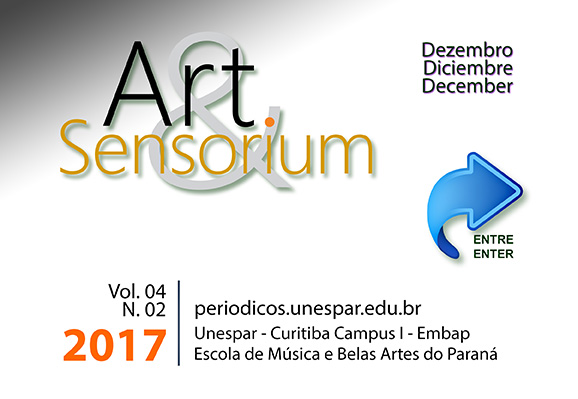LINHAS DE ÁGUA DE MÁRIO CESARINY E FONTES DE SINTRA DE ANTÓNIO DACOSTA COMO TERRITÓRIO DE CONVERGÊNCIA: VISUALIDADE PLÁSTICA E POÉTICA
DOI:
https://doi.org/10.33871/23580437.2017.4.2.001-014Keywords:
Artes Visuis, Interdisciplinaridade, Arte ContemporãneaAbstract
O artigo tem como objetivo estudar a persistência do elemento líquido, recorrente no imaginário surrealista português, em obras como Linhas de água de Mário Cesariny ou Fontes de Sintra de António Dacosta, numa articulação com as poéticas dos autores e de António Maria Lisboa.O estudo evidencia uma identificação com o feminino e o materno, assumidos como espaço de integração e unificação, testemunho de um sentimento primitivo de unidade e integridade corporal. Na obra de Mário Cesariny, o mar, representado exaustivamente nas Linhas de água e evocado nos poemas, impõe-se como elemento transformador que desmaterializa, dissolve e incorpora o ser, reintegrando-o numa dimensão una. O mar, entendido como elemento dissolvente e reconstituinte, força destrutiva e transformadora é a metáfora do processo criativo. Na obra de António Dacosta o elemento líquido assume igualmente uma expressão integradora e unificadora, metáfora do espaço-tempo materno. A análise e interpretação da série Fontes de Sintra evidencia a representação de um espaço-tempo ideal, destituído de angústia e ansiedade, anterior a qualquer separação ou perda, implícito na imagem da fonte entendida como retorno às fontes matriciais, na firmação do espaço fechado como metáfora da intimidade materna ou no entendimento da água como substância nutritiva ou leite inesgotável.
Downloads
Downloads
Published
Issue
Section
License
Copyright (c) 2022 International Interdisciplinary Journal of Visual Arts - Art&Sensorium

This work is licensed under a Creative Commons Attribution 3.0 Unported License.
Authors who publish with this journal agree to the following terms:- Authors retain copyright and grant the journal right of first publication with the work simultaneously licensed under a Creative Commons Attribution License that allows others to share the work with an acknowledgement of the work's authorship and initial publication in this journal.
- Authors are able to enter into separate, additional contractual arrangements for the non-exclusive distribution of the journal's published version of the work (e.g., post it to an institutional repository or publish it in a book), with an acknowledgement of its initial publication in this journal.
- Authors are permitted and encouraged to post their work online (e.g., in institutional repositories or on their website) prior to and during the submission process, as it can lead to productive exchanges, as well as earlier and greater citation of published work (See The Effect of Open Access).


